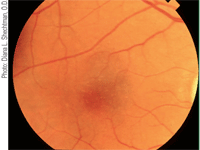A new University of Buffalo study suggests that women under the age of 75 with high vitamin D status are less likely to have early age-related macular degeneration (AMD).
Lead author Amy E. Millen, Ph.D., said that women under the age of 75 with lower than 38 nanomoles per liter of vitamin D concentrations were more likely to have age-related macular degeneration than women with 38 nanomoles per liter. She further went on to add that blood concentrations above 38 nanomoles per liter were associated with at least a 44% lower chance of developing AMD. Being at a higher level than 38 nanometers per liter of vitamin D does not appear to be more protective.

Women with higher dietary intake levels of vitamin D are less likely to manifest symptoms of early age-related macular degeneration, as seen in this patient.
The Institute of Medicine considers an adult with lower than 30 nanomoles per liter of vitamin D concentration to be vitamin D deficient and a person with a concentration of less than 50 nanomoles per liter to be at an increased risk for vitamin D inadequacy.
Vitamin D may be increased by spending moderate amounts of time outside, eating foods rich with vitamin D such as fatty fish, fortified milk and fortified cereal, and by taking supplements.
Millen AE, Voland R, Sondel SA, et al; for the CAREDS Study Group. Vitamin D Status and Early Age-Related Macular Degeneration in Postmenopausal Women. Arch Ophthalmol. 2011 Apr;129(4):481-9.

